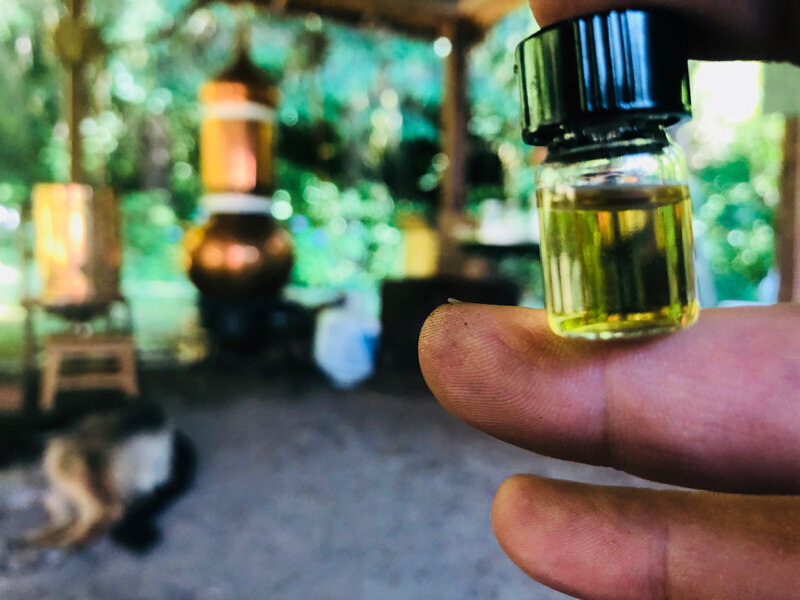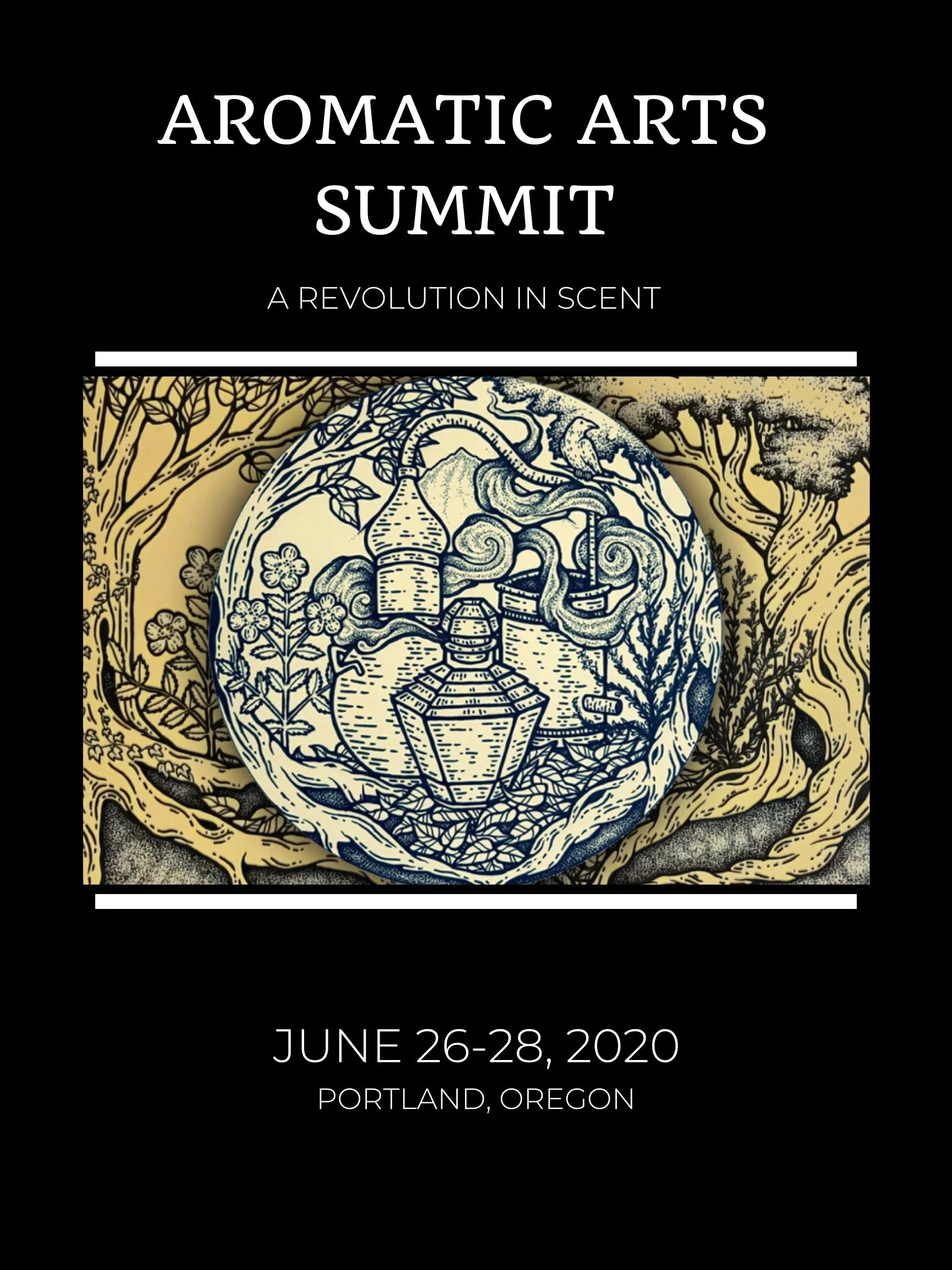The Future of Scent: The Aromatic Artisan Renaissance
Human beings are in the midst of a dramatic revolution in how we perceive scent. Prior to the 1800’s, most people worked outdoors, lived on farms and were engaged in agrarian work. Starting in the 1800’s, people began to migrate to cities to work in factories and offices. Today, modern humans spend 90 percent of their time living and working indoors. At the same time, we started introducing artificial scents into our homes and offices and now the vast majority of scent compounds we inhale come from synthetic fragrances such as fabric softener, detergents, soaps, shampoos, new carpeting and furniture.
As we have increasingly come to understand the dangers of artificial scent in terms of carcinogenic phthalates and other compounds, many of us are reintroducing botanical based scents into our lives. But simply relying on aromatic plants presents challenges in terms of sustainability and we are in the midst of a renaissance of reconnecting to traditional ways of working with aromatic plants that is both sustainable and reverent. But first a little history.
Over 150 million years ago, flowering plants known as angiosperms evolved [1] and started to diversify into the many families of plants we know today. The first flowers were small and not showy, but as flowering plants developed petals, they exploded into wild shapes and colors that helped provide evolutionary advantages to attract pollinators. Plants also started to diversify their scent profiles into the magical and entrancing fragrances we know today.
Scent has always played a deeply important role for flowering plants. Tiny low weight aromatic compounds easily volatilize into the air to attract pollinators. Think of a bee drawn to the scent of a rose, dipping its insect legs into the flower as a trade off. The bee receives the sugary nectar essential for its survival and the bee inadvertently takes pollen over to female flower to help in the process of reproduction. This mutually beneficial relationship between insects and flowers has helped both to diversify and flourish.
These aromatic compounds also helped to protect against bacterial, fungal and predator invasions that could wipe out whole colonies of plants. Consider a western red cedar that has fallen but hasn’t broken down in over a hundred years. The cedar compound thujaplicin acts as a key fungicide that wards off decomposition. For plants, volatile compounds act as the essential mediators that communicate both attraction and repulsion.
HUMANS AND AROMATIC PLANTS
Modern humans entered the picture several hundred thousand years ago and started to migrate out of Africa to colonize the world about 80,000 years ago. During this great trek, humans encountered all the plant families of the world and developed a deep relationship with aromatic plants. [2]
Aromatic plants act in a number of ways that are profoundly helpful for humans. Many of them are medicinal and can act to improve health complaints. Mediterranean herbs such as rosemary, sage and thyme are antibacterial and can help us to digest our meals more properly. Central and East Asian plants like cumin, clove, turmeric and cardamom improve the taste of food, improve digestion, have antibacterial effects and can help open the pores to allow sweating to help break a fever. Tea tree and eucalyptus help relax and open bronchioles to allow for easier breathing and to help with conditions such as bronchitis. Cottonwood buds can be infused in oils and fats to help sooth skin burns, irritations and small scrapes and bruises.
Aromatic plants have also played an enormous role in spirituality. Resins like frankincense and copal and plants such as mugwort, sweetgrass, sage and tobacco have been burnt as smoke medicine for thousands of years to consecrate sacred places, and to create the setting for prayer, meditation and supplicating the divine.
In the early years of modern civilization, humans developed techniques to extract plant volatiles to make oils, unguents, aromatic waters and perfumes to adorn, augment beauty and to repel fetid scents that were common before refrigeration and sanitation. A huge revolution occurred around 1000 AD when Persians such as Ibn-Sina developed a still with a coil that allowed for greater separation of the aromatic waters (hydrosols) from the essential oils. [3, 4]
By the 1100s distilling was brought to Europe and helped start a renaissance in our connection to scent. The still became a centerpiece for our relationship to the natural world. From the still sprang various disciplines that have radically changed the human experience. The distillation of hydrosols and essential oils helped advance perfumery and cosmetic herbalism. The distillation of alcohol started the revolution in the production of spirits for recreational enjoyment and the making of tinctures and medicinal liquors. Distillation also formed the basis of alchemical practice, the making of spagyric essences and created the foundation for the field of chemistry.
SCENT IN MODERN TIMES
Up until the 19th century, all the scents we experienced derived directly from humans and the land; its meadows, farms, forests and various flora and fauna. This all changed in the 1800s when laboratory scientists were able to synthesize aromatic constituents from petroleum. The production of synthetic coumarin led to the production of Houbigrant’s Fouler Royale perfume. In 1889 the “Jicky” perfume was produced with synthetic vanillin. This was seen as an amazing leap forward as perfumers no longer had to go through the complex and expensive process of acquiring and processing vanilla beans, and the scent of synthetic vanilla also had longer staying power on the skin, extending the life of a perfume. [5]
This introduction of synthetics in perfuming led to a massive revolution in the use of artificial scents in many areas- culinary, cosmetic and household cleaning. By the mid-1900’s our scent landscape became dominated by artificial fragrances. From laundry and dish detergent to soaps and shampoos to the smell of new furniture and the fragrances pumped in stores and malls, artificial fragrance supplanted scents derived from botanical extracts.
At the same time this was happening, humans also took a journey from working primarily outdoors in agrarian environments to working indoors in factories and offices. Today Americans spend 90 percent of their time indoors and commuting in cars. We are no longer connected to the natural world and its smells on a daily basis. Instead we have to make time for gardening, a stroll through a park or a hike in the woods to connect to any of those volatile scents that naturally emit in the air from plants.
This radical departure from natural scents to artificial scents has come at a cost. Increasingly people are complaining of health problems related to artificial fragrance. Many people have developed sensitivities to synthetic smells that could make one sick. From dermatitic reactions to cases of asthma attacks and increased autoimmune flares, artificial fragrance is seen increasingly as “scent pollution.” Researchers have also discovered that many synthetic fragrances contain carcinogenic phthalates that are associated with higher risks of cancer. [6,7,8,9,10]
We have created scent landscapes that are suffused with artificial scents. What we know is that scent is processed primarily in the limbic system associated with memory and emotions. This is where our core memories are stored. And in the last 100 years, our fragrance environment has been dominated by detergents, soaps, cleaning agents and furniture and carpet smells imbedded with synthetic scents. We are forming memories that are associated with a variety of industrial scents derived from petrochemicals. In many ways we have deadened our true sense of smell to receive only false chemical mimicry of the natural world. And because of that deadening, we have become increasingly disconnected from the natural world and its flora and fauna.
BACK TO THE LAND
In this environment, more and more people started to look into ways of returning to botanically derived scents. Since the 1930’s, aromatherapists had known about the importance of essential oils in helping people with various physical and emotional complaints. [11] Research validated that scents such as lavender reduce blood pressure and help improve mood and wellbeing. [12] By the 1990’s, large industrial companies popularized essential oils by mass producing them. Soon they were available to the public at natural grocery chains and herbal stores. Exotic oils such as vetiver and bergamot could now be purchased for a song. As the internet took off, essential oils became increasingly available and today the market for these oils tops 7 billion per year.
While the desire for returning to natural botanical extracts is a noble move away from the problems and dangers of artificial scents, this exodus to botanical oils has led to other problems. The issue of sustainability and the ethics of using essential oils has been put under a microscope.
Some of the main critiques include:
It takes an enormous amount of botanical material to produce a fraction of essential oil. Mass production of these oils is not agriculturally sustainable in many cases.
Many aromatic plants such as sandalwood and rosewood are endangered and have been unethically processed into essential oils by large companies.
Some industrial botanical companies adulterate their oils with synthetics to reduce the need for processing botanicals and to add more aromatic intensity.
Many essential oils derive from plants grown in industrial agricultural environments with pesticides that can transfer via distillation to the essential oils.
Some essential oils can be caustic and cause severe reactions and most are unsafe to internally consume at concentrated levels.
AROMATIC ARTISANS
Out of these necessary criticisms, a new movement has grown that I call the aromatic artisan renaissance. This is a movement of herbalists, distillers, incense makers, natural perfumers and aromatherapists who care deeply about the ethics and sustainability of working with botanical extracts. Increasingly these artisans are turning towards direct relationships with the plants and learning the craft of making preparations from their homes, farms and small businesses. And increasingly, these artisans have been looking at exploring aromatic plants outside of just essential oils.
Instead of distilling a large amount of botanical material for essential oils, there are a variety of other ways to access aromatic plants. From incense to smoke medicine, infused herbal oils and salves, tinctures and teas, aromatic plants can be experienced in a variety of ways. Perhaps the largest revolution has happened in integrating hydrosols, the aromatic water distillate that has often been seen as an inferior side product from the real work of producing essential oils. A far larger amount of hydrosol is produced during distillation then essential oil. If I were to distill about 4 kg of Douglas fir, I may receive a half ounce of essential oil but would receive a gallon of hydrosol.
The use of hydrosols has been exploding lately. From culinary uses (rose water), to the booze and cocktail industry, integrating them into cosmetic creams, as cleaning agents, diffusing them as sprays and for their aromatherapeutic value, hydrosols are seen as a step towards greater sustainability and an important medicine in its own right that differs from essential oils. Hydrosols are also quite a bit gentler and can be used in larger amounts and rarely cause adverse effects that are seen at times with highly concentrated essential oils.
THE FUTURE OF SCENT
So we are at a tipping point. We are experiencing multiple ecological catastrophes and resource depletion paired with the unfolding disaster of climate change. As we stand in the midst of the 6th major extinction event in Earth’s history, we need to ask ourselves a necessary question. Is it okay to work with aromatic plants that integrates their use for medicine, perfumery and spiritual purposes?
I believe that now more than ever we need to return to direct, experiential relationships with the plants that honors their value and supports their propagation and sustainability. That means thinking very carefully about the ecological cost of growing, wildcrafting and harvesting plants for their aromatic properties. We need to incorporate a wide variety of ways to work with aromatic plants outside of just using essential oils. Working with incense, infused oils and salves, hydrosols and smoke medicine are a number of ways to honor aromatic plants that uses far less botanical material. When we work with essential oils, we should think extremely carefully about the amount of botanical material needed, the ethics of harvesting and distilling that particular plant and using those essential oils wisely and sparingly.
For example, I recently gathered fallen boughs of Douglas fir and distilled the branches before returning the spent marc back to the forest floor to decompose. In essence I am simply borrowing the aromatic volatiles from the plant while not disturbing the environment greatly.
The more we work with aromatic plants at a community level, purchasing communal stills, borrowing and sharing equipment and working in groups to gather and process, we not only build an alliance with the natural world but with each other as well. And in the process we regain our sense of smell, our true ability to detect those innumerable volatiles emanating from plants, We develop new core memories of integration and relationship to the plant world that have long been part of our ancestral lineage. And finally we regain power that we have ceded over to large industrial botanical essence companies and artificial scent producers. We learn to make our own connections at an individual and community level that builds resilience and strengthens our relationship to the ineffable magic and beauty of the botanical world.
REFERENCES
Bell CD, Soltis DE, Soltis PS. (June 2005) The age of the angiosperms: a molecular timescale without a clock. , retrieved from https://www.ncbi.nlm.nih.gov/pubmed/16050101
Alex, Bridget, (May 2019) Prehistoric Medicine: How Archaic Humans Cured Themselves, 2019, Discover Magazine
Vinepair Staff, (2014), The History Of Distilling, Vinepair
Avicenna (Ibn Sina) (c. 980-1037) Internet Encyclopedia of Philosophy
Stamp, Jimmy, (Jan 2013) Jicky, the First Modern Perfume, Smithsonian
EPA: Report on the Environment. What are the trends in indoor air quality and their effects on human health?
Children’s Environmental Health Network: What are fragrances and how are children exposed?
Scheer, Moss (September 2012) Scent of Danger: Are There Toxic Ingredients in Perfumes and Colognes? Scientific American
Potera, Carol (Jan 2011) Indoor Air Quality: Scented Products Emit a Bouquet of VOCs Retrieved from https://www.ncbi.nlm.nih.gov/pmc/articles/PMC3018511/
Zanolli, Lauren (May 2019) Why Smelling good could come with a cost to health, The Guardian
Malcolm ad Tallinn (Jul 2017) Essential oil of lavender in anxiety disorders: Ready for prime time? Retrieved from https://www.ncbi.nlm.nih.gov/pmc/articles/PMC6007527/
Krusemark, E., Novak, L., Gitelman, D. and Li, Wen (Sep 2013) When the Sense of Smell Meets Emotion: Anxiety-State-Dependent Olfactory Processing and Neural Circuitry Adaptation, Retrieved from https://www.ncbi.nlm.nih.gov/pmc/articles/PMC3782615/
This article was written by Jon Keyes. For more articles like this, please visit www.hearthsidehealing.com and visit us @aromatic_arts_










